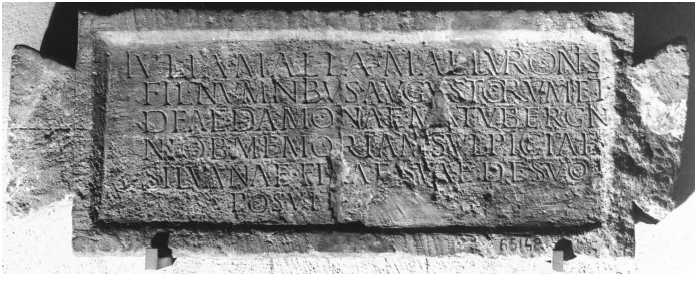e) Saintes (Charente)
In the south-west of Gaul, Damona is venerated on her own in an inscription, engraved on a triangular slab broken in three pieces, found in 1918 on a hill at a place known as ‘La Garenne’, in Saintes (Charente). The dedication is the following: Jullia Malla Malluronis fil(ia) Numinibus Augustorum et deae Damonae Matuberginni ob memoriam Sulpiciae Silvanae, filiae suae, de suo posuit, ‘To the divine powers of Augustus and to the goddess Damona Matuberginnis, Julia Malla, daughter of Malluro, had (this monument) erected in the memory of her daughter Sulpicia Silvana’ (fig. 47).2070 Various objects from Gallo-Roman times, such as fragments of vases, roughly-hewed stones and a millstone, were discovered in the area. This could indicate that a small temple or shrine was erected on the hill, but this remains unconfirmed.

The dedicator’s father is a peregrine* with a Celtic name, while Julia Malla bears the duo nomina of Roman citizens. Her first name Julia is Latin, but her second name Malla is clearly Celtic. It is based on the same theme mallos, probably meaning ‘slow’, ‘lazy’, as her father’s name Malluro.2071 Julia Malla prays to the goddess Damona for the memory of her daughter Sulpicia Silvana, who has two Latin names. She might have had a monument erected in honour of Damona, such as an altar or a temple, but no archaeological evidence has been discovered in the area. This inscription is interesting, for it illustrates the complete Romanization of a Celtic family in three generations.
Damona is given the epithet Matuberginnis, the significance of which can be interpreted in various ways. In the 19th c., Antoine Héron de Villefosse suggested that it was a localizing epithet designating the place where the goddess Damona was honoured.2072 Matuberginis may be composed of Celtic matu-, ‘bear’ and of Celtic bergo -, ‘mountain’ or ‘hill’. Accordingly, the place of devotion to Damona would have been called ‘the Hill of the Bear’. As explained in Chapter 2, matu- can also signify ‘good’ or ‘favourable’, for it was used as a circumlocution or a flattering epithet not to offend a potentially dangerous animal.2073 Olmsted thus proposes that Matuberginnis is a descriptive epithet qualifying the goddess as ‘the Good or Favourable High One’.2074 This root is found in other epithets of deities, such as Diana Mattiaca and Apollo Matuacus or Matuicus.2075
As Damona is attached to curative springs in the centre of Gaul, it is likely that she was related to a spring or a fountain in the area. Jules Lhomme, who investigated the place in 1918, did not find any springs, but he did discover a well supplied with a subterranean spring.2076 No archaeological discoveries yet provide evidence of a cult rendered to Damona at this well.